Are you looking to dive deep into the history and heritage of India and go back in time to the 4th century and beyond? Then, Madhya Pradesh with gems of heritage scattered along its length and breadth is the place to head to. The monuments of Sanchi, the temples of Khajuraho, and of course the magnificent Udayagiri Caves Vidisha are some of the gems that are strewn into the garland of heritage that adorns the heart of India, Madhya Pradesh.
If the UNESCO World Heritage Site of the group of monuments of Sanchi stands as a virtual timeline of Buddhism in India, the Udayagiri Caves near the ancient city of Vidisha are believed to be the home of the oldest known forms of Hindu iconography. The Udayagiri Caves near Sanchi contain sculptures, symbols, and inscriptions that date back to the 4th and 5th centuries CE, to the Gupta Period. The most iconic of these is the imposing Varaha Image at Udayagiri. Read on to delve deeper inside the intriguing Udayagiri Caves Madhya Pradesh.
Table of Contents
Udayagiri Caves Vidisha – A 5th Century Wonder
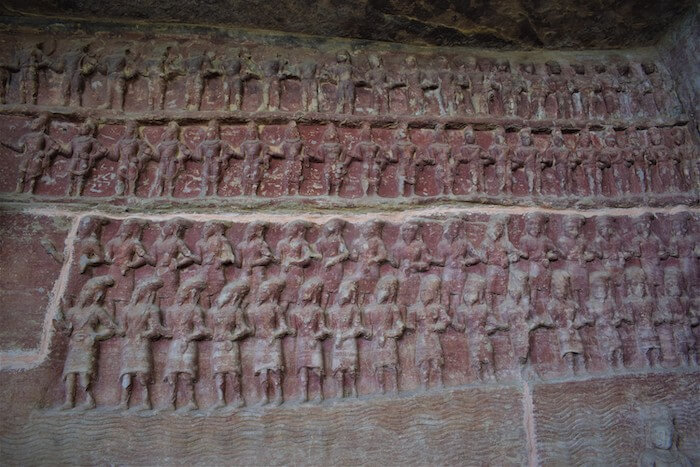
As we disembark from our vehicle near the parking lot of the Udaigiri Caves, a board put up by Madhya Pradesh Tourism, greets us. It gives a brief about the caves and their history.
“The caves of Udaigiri are an exquisite illustration of the local art form. These were established by Chandragupt Vikramaditya, after defeating Shakas in the 4th and 5th centuries. The primary motive behind the construction of these caves and the establishment of sculptures of different deities clearly seems promotion of Jainism among the common folk. There are in total 20 caves out of which two are related to Jainism and the remaining eighteen to Hinduism directly. On the top of the caves remains of the Mauryan, Shunga, and Naga dynasties have been found, which also includes Buddhist Stupas.”
Visiting The Historic Udayagiri Caves
A paved pathway leads from the parking lot and ticket counter towards the Udaigiri caves. The path runs parallel to the road on the left, while on the right is the imposing cliff face of the Udayagiri hill.
The main caves lie towards the left of the parking lot, and that is where we headed with anticipation to catch a sight of what is believed to have been some of the earliest Hindu sculptures, temples, and iconography.
The Twenty Rock-cut Caves of 5th Century Udayagiri Caves
There are a total of 20 caves that have been cut into the face of the rock. Some are small niches, while others are big rooms with deities and big sculptures. !8 of the caves are dedicated to Hindu deities, inscriptions, and symbols, while two of the Udaygiri caves are related to Jainism. Here is a list of Caves and what you can see in them. They are not in chronological order, but rather arranged in order of their historical and visual impact. Here are the most important and must-visit caves at Udayagiri Madhya Pradesh.
Important Caves in Udayagiri MP
Though each of the 20 caves of Udayagiri has its own importance and are a part of India’s rich heritage. The main caves that will grab your attention at Udayagiri near Bhopal are the ones listed below.
Udayagiri Caves – Cave Number 5 (Varaha Image At Udayagiri)
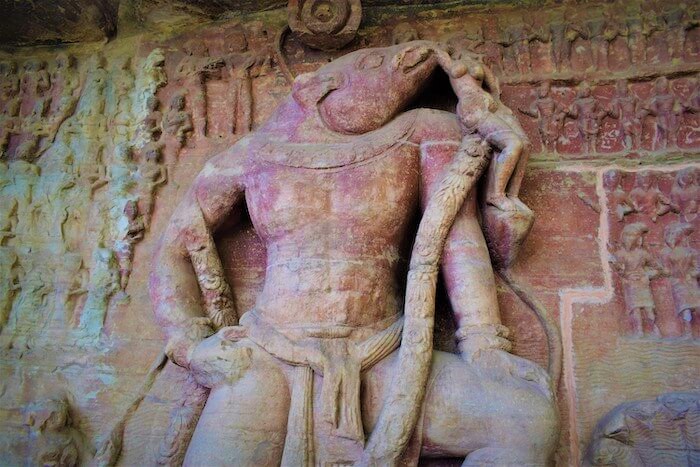
The most iconic and enduring image that will haunt you for long after leaving the Udayagiri Caves Vidisha is that of the magnificent Varaha in Cave number 5. Your breath is sure to stop for a couple of seconds when you stand in front of the massive Varaha panel. Housed in a cave which is more of a niche, this amazing work of art chiselled in rock speaks volumes of the craft of the workmen who conceived and executed it, thousands of years ago.
This rock-cut sculpture is believed to be one of the earliest Hindu iconographies dating back to the 4th and 5th centuries. Apart from its colossal size, the Varaha image stuns you with its detailing. The Varaha sculpture represents one of the most famous incidents from Hindu mythology. This incident has been mentioned in various ancient Vedic texts including the Taittiriya Samhita of the Yajurveda. Here Vishnu is alluded to as Prajapati. it is later on that Varaha as the avatar of Vishnu developed.
“This was, in the beginning, the waters, the ocean. In it Prajapati becoming the wind moved. He saw her, and
becoming a boar he seized her. Her, becoming Viçvakarma, he wiped. She extended, she became the earth,
and hence the earth is called the earth (lit. ‘the extended’). In her Prajapati made effort. He produced the gods,
Vasus, Rudras, and Adityas. The gods said to Prajapati, ‘Let us have offspring.’ He said [1], ‘As I have created
you by penance, so seek ye offspring in penance.’ He gave to them Agni as support, saying, ‘Strive with that
support.”
This is an excerpt from the Taittiriya Samhita, here Vishnu is referred to as Prajapati and also you can see the mention of Vasus, Rudras, Agni, Adityas, etc. The panel that depicts the Varaha image in Udayagiri, includes images of these and much more. It is a fascinating and huge canvas on the rock.
The legend that is depicted in the panel within Cave number 5, goes thus.
Hiranyaksha a terrible and oppressive demon kidnaps Bhudevi, the Goddess Earth and hides her in the depths of the cosmic ocean. This threatens the very existence of life and the entire earth. Bhudevi’s existence and all the life she supports is at stake as she is drowning in the ocean. Vishnu in the form of a Boar comes to the rescue as Varaha, the third of the 10 avatars of Vishnu. He dives into the ocean and finds Bhudevi, who clings on to his tusk and Vishnu in the form of the boar lifts her to safety. Thus symbolically demonstrating the triumph of good over evil.
The panel in Cave number 5, has a massive sculpture of Varaha, a sinuous and fierce-looking entity. Hanging on to his tusk for dear life is the form of a beautiful Bhudevi. This of course is the main part of the panel. However do pay attention to the smaller sections of the panel, and you would be awed by the expanse that is covered.
Sitting on a lotus, very near the snout of Varaha can be seen a small image of Brahma, the God of creation. Not far from Brahma can be seen a miniature image of Shiva, seated on his Nandi. The panels to the right of the main sculpture of Varaha, contains images of 12 Adityas, the 8 Vasus, the 11 Rudras, and Agni the God of Fire along with Vayu, the God of the Wind. A row of sages and other ascetics can also be seen towards the right of Varaha.
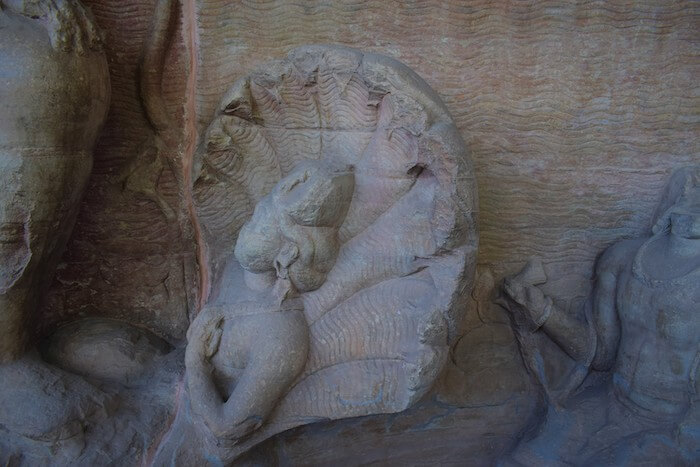
The Goddess Lakshmi can be seen near the foot of Varaha on one side, while on the other side is the image of a Nagdeva. But what is really fascinating is the presence of smaller images near the foot of Varaha that depict Emperor Chandragupta II himself as well as his minister by the name of Virasena. Elsewhere above the shoulder of Varaha can be seen the images of Sage Narada and Sage Tamburu.
The Rock Sculpture ff Vishnu as Varaha rescuing Bhudevi is one of the most important historic sculptures of India as well as one of the oldest.
Udaigiri Caves – Cave Number 7 ( The Tawa Cave)
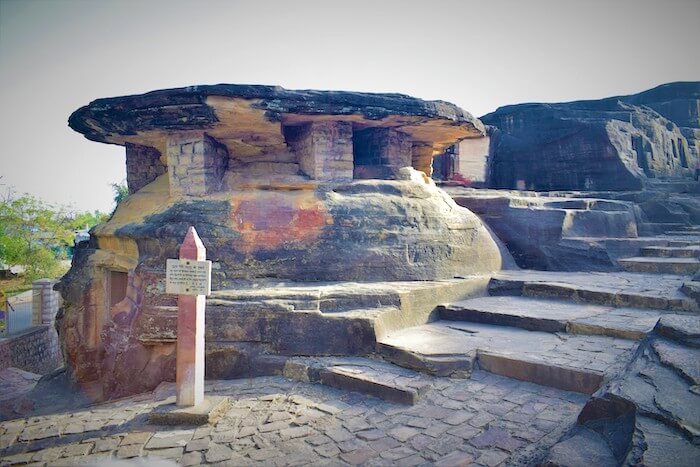
As you walk towards the Udayagiri caves, an unusual structure greets you even before you reach the cave that has the famous Varaha statue. This is Cave number 8 which is also referred to as Tawa Cave. This nomenclature is self-explanatory as the roof of the cave is flat and shaped like a girdle (Tawa).
Other than the novelty of its shape the importance of Cave number 8 is an inscription on its rear wall that mentions the visit of Chandragupta II and his minister Virasena. The inscription in Sanskrit roughly translated into English reads thus:
“The inner light which resembles the sun, which pervades the heart of the learned, but which is difficult find among men upon the earth, that is the wonder called Chandragupta, Who * * * (damaged), Of him, like a saint among great kings became the minister […], whose name was Virasena, He was a poet, resident of Pataliputra, and knew grammar, law and logic, Having come here with his king, who is desirous of conquering the whole world, he made this cave, through his love Shambhu.”
Udayagiri Caves – Cave Number 6
Cave number 6 of the Udayagiri Caves is a fascinating fusion of what later developed into different sects of Hindu worship. This cave embodies the synthesis of Vaishnavism, Shaivism, and the Shakti cult of worship. You can see images of Shiva, Vishnu, and Durga on the outer walls o the sanctum that has been cut into the rock face. The cave is also known as, “Sankanika Cave,”, after a local tribal chief whose inscription can be found in the cave. The inscription speaks about the victory of Chandragupta II over the North-Eastern Malwa Region.
The sanctum has a T-shaped door which is flanked by dwarpalakas (Guards) on either side. The figures of Vishnu on one side of the door and Shiva on the other side can be seen.
There is also a figure of Durga as Mahishasuramardini near the door to the sanctum. This is believed to be one of the earliest depictions of Durga in this form.
Inside the sanctum, one can see a semi-finished Shiv Linga. Another important sculpture that can be seen here is that of the elephant God Ganesha. He can be seen seated in a niche, complete with pot-belly and modak in one of his hands. There is a small niche by the side of this cave that has broken images of Matrikas or a group of Mother Goddesses in Hinduism.
Udayagiri Caves – Cave Number 12
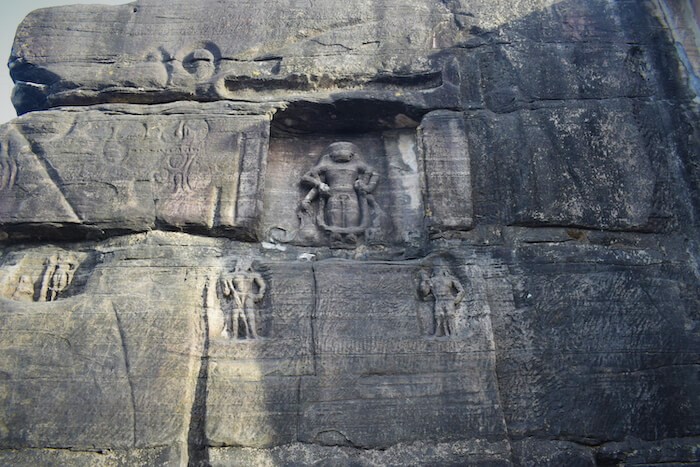
A small niche houses the image of a standing Vishnu in the form of the Narasimha avatar. Vishnu is seen as a half-man and half-lion. This again is the earliest known depiction of the Narasimha avatar of Vishnu. Just below the niche can be seen the two Dwarpalakas or gatekeepers of Vishnu, Jaya and Vijaya.
Some large shell inscriptions can be seen on the face of the rock here. However, historians believe that these inscriptions could have pre-dated the rock sculptures which could have been cut over them.
Udayagiri Caves – Cave Number 13 (Sheshashayi Vishnu)
A massive sculpture of a sleeping Vishnu in the classic Sheshashayi or Anantashayana position greets you in Cave 13 of the Udayagiri Caves. Vishnu can be seen lying on the coil of a primordial snake, Adishesha with his vehicle Garuda in attendance. His head is resting on the palm of one of his four hands. At the feet of Vishnu can be seen the figures of two men prostrating respectfully. It is believed that these are probably the images of Chandragupta II and his minister Virasena. This Vishnu image is one of the earliest known sculptures of Vishnu in this posture. This Cave of Vishnu is also known as the God’s Gorge
Other Important Caves of Udayagiri
Most of the focus is on the central group of caves which are described above. However, there are other caves that are located towards the left and right of these caves that are also interesting.
Cave Number 1
This is a cave that has been built into a rock face and has a portico supported by 4 pillars. The niche of the rock and its top serves as a natural sanctum and roof. The main idol is missing here, however, the presence of a sculpture of a Jain Tirthankara has survived the ravages of time.
Cave Number 3
This cave has a sanctum that houses an image of Skanda or Kartikeya, hence it is also referred to as the Skanda temple. This again is believed to be one of the earliest representations of Skanda. Evidence suggests the existence of a portico or Mandapa in front of the sanctum which has been destroyed by the ravages of nature and time.
Cave Number 4
This cave houses a beautiful Shiv Ling which is an Ekamukha Linga, or single-faced Linga. The Shiva Linga has a beautifully carved face, and also the Jata or curls of Shiva are beautifully carved. The cave also has the remains of the sculptures of Matrikas.
Udayagiri Caves History
The history and architecture of Udayagiri Caves Vidisha are really fascinating. The caves are invaluable as they are proof in stone of the religion and culture dating back to the 4th and 5th centuries, to the Gupta Period.
The many inscriptions found at the Udayagiri Caves point to the fact that the Udayagiri Caves were built by Chandragupta II during the last decade of the 4th century and the beginning of the 5th century. It is believed that the caves were consecrated in the year 401 CE.
Archaeological evidence also suggests the existence of a continuous human settlement from Vidisha to Udayagiri. It is believed that Udayagiri could have been a suburb of Vidisha. The importance of Udaigiri as an important place of pilgrimage for Hindus is evidenced by various inscriptions that talk of grants or donations to the temples for their upkeep and maintenance.
The Udayagiri caves were also important pilgrimage sites of Jainism and also Buddhism, before the Gupta period.
How To Get To Udayagiri Caves | Udayagiri Caves Location
- The Udayagiri Caves are located about 9 kilometres from the famous town of Sanchi and can be easily visited along with the Sanchi Stupa
- Sanchi is located at a distance of 49 kilometres from the capital of Madhya Pradesh, Bhopal
How To Reach Sanchi By Air
The nearest airport to Sanchi is Bhopal’s Raja Bhoj Airport located at a distance of 55 kilometres. Bhopal is fairly well connected to cities across India by air. There are flights to and from places like Mumbai, Delhi, Pune, Ahmedabad, Bangalore, Hyderabad, Chennai, etc., at the Bhopal Airport.
How To Reach Sanchi By Train
There is a small railway station in Sanch which currently does not have many facilities. It is being developed for better services. The best option of your thinking of travelling by train is to travel to Bhopal by train and then proceed by road to Sanchi.
How to Reach Sanchi By Road
Sanchi is well connected by road with major towns and cities of Madhya Pradesh and India. You can use Public Transport or hire a cab or do a road trip to Sanchi.
Do the Images Of Udayagiri Caves Varaha, and other sculptures pique your interest? Are you are planning a trip to Sanchi in Madhya Pradesh, India to see the Udayagiri Caves and the famous Sanchi Stupa and the Sanchi Archaeological Museum, then you can very conveniently book a cheap flight right here through one of the options, TripAdvisor or CheapAir or Cleartrip or Makemytrip or Priceline right here. If you are planning to travel by road from Bhopal to Sanchi, some of the options are by self-drive car or cab or bus.
Where To Stay While Visiting Udaigiri Caves MP
Sanchi offers many options for stay. One good option is the MPT Gateway Retreat which is a nice property on the main road, run by Madhya Pradesh Tourism.
If you are looking to book a hotel in Sanchi or a resort in Sanchi or accommodation anywhere in Madhya Pradesh or India or the world, you can do that right here. You can book Sanchi hotels through TripAdvisor or Cleartrip or Makemytrip or Priceline and save on your bookings by availing of discounts.
| Click to book the best hotels in Sanchi |
|---|
Other Amazing Places To Visit Near Sanchi
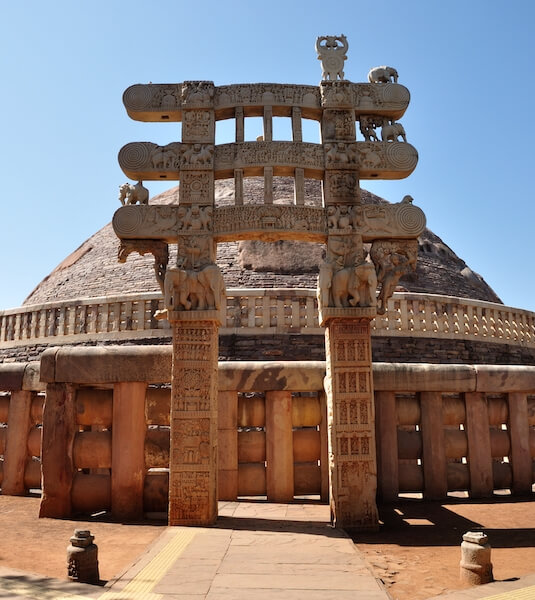
Sanchi and its vicinity is a treasure trove of heritage. There are many places to visit here and elsewhere in Madhya Pradesh. Some of the places to visit near Sanchi are listed here.
- Sanchi Stupa
- Sanchi Archaeological Museum
- Vidisha
- Bhopal
- Bhojpur
- Bhimbetka
Madhya Pradesh is a traveller’s delight with its rich heritage and many natural wonders that include Tiger Reserves like Kanha and Pench, if you are trying to decide on what to see in MP or what to do in Madhya Pradesh, then look no further. Book online places to see in Madhya Pradesh and cover attractions in Bhopal and MP.
| Click here to know more and book Best Attractions in Madhya Pradesh |
|---|
We hope you liked reading our Udayagiri Caves blog post and found it informative and useful. Do reach out to us with your questions, comments, and suggestions. And do not forget to subscribe to our blog and connect with us through our social media channels.
Below are some useful resources to help you book flights, hotels, and tours! And also clothes, luggage and accessories for your trip!
Flights – TripAdvisor or CheapAir or Cleartrip or Makemytrip or Priceline
Tours – Click here to book top tours around the world
Hotels – Click to book the best hotels/resorts
Choose best stay options with TripAdvisor or Cleartrip or ixigo or Makemytrip or goibibo or Hotelscombined or Priceline
Apparels – Click to buy Menswear or Womenswear or Kidswear
Accessories/Luggage – Click to buy Accessories and Luggage items
Beauty Products – Click to buy Personal Care and Beauty Products
Do You Love Traveling?
Do you want to know how to travel the world? We have put together a very useful travel resources page with the best travel tips. Go check it out now.
Thanks for visiting our site Voyager – imvoyager.com and taking the time to read this post!
If you wish to collaborate/work with us then reach us at [email protected]
We’d love it if you’d comment by sharing your thoughts on this post and share this post on social media and with your friends.
Follow our journey on our social media channels:
Facebook Twitter Instagram Pinterest YouTube
60+ Million Users Trust TripAdvisor With Their Travel Plans. Shouldn’t You?

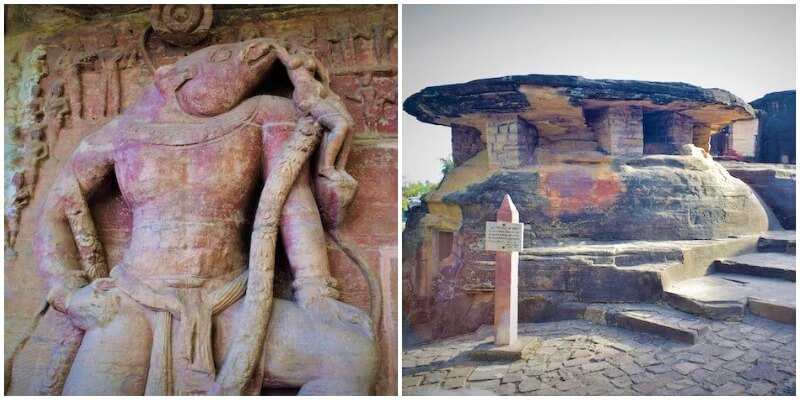
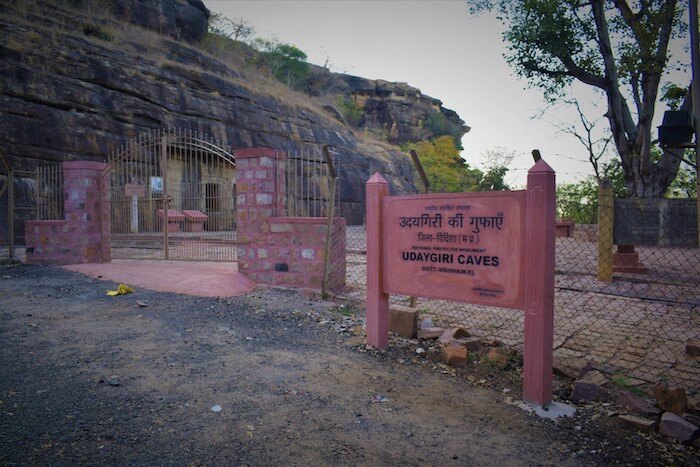
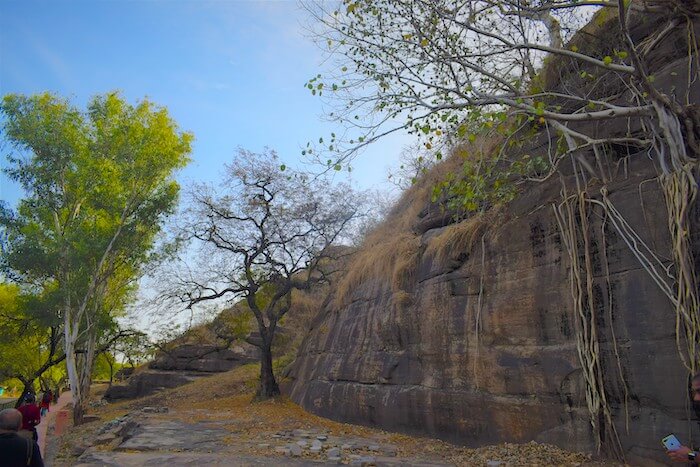
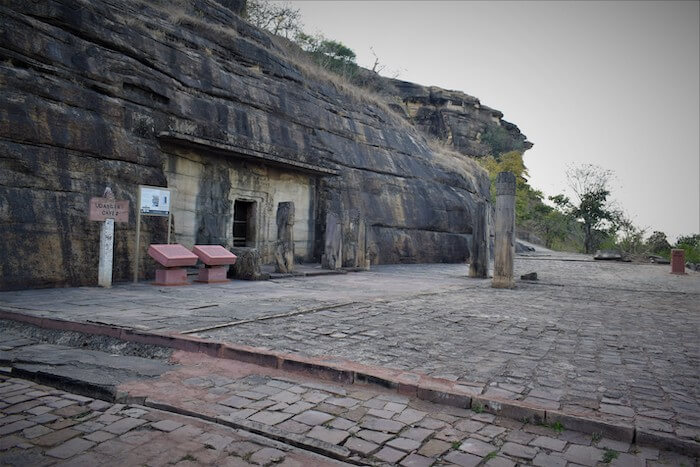
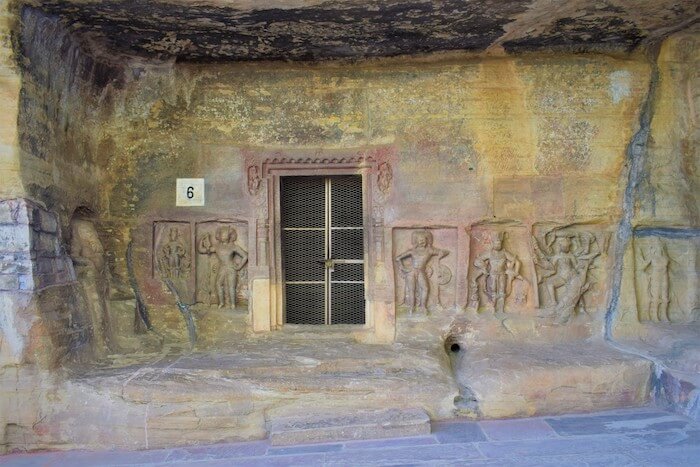
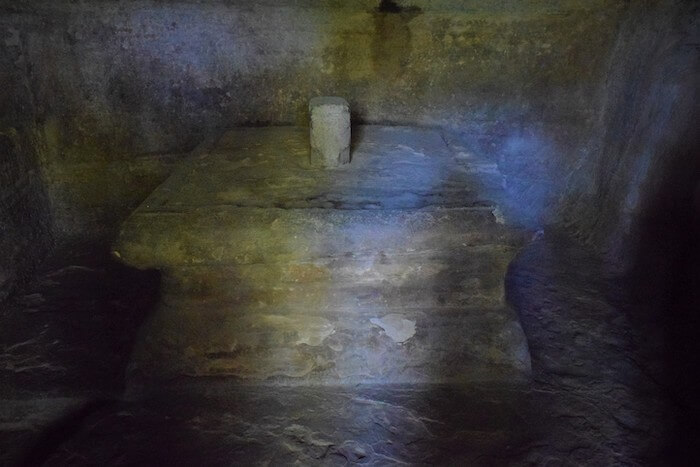
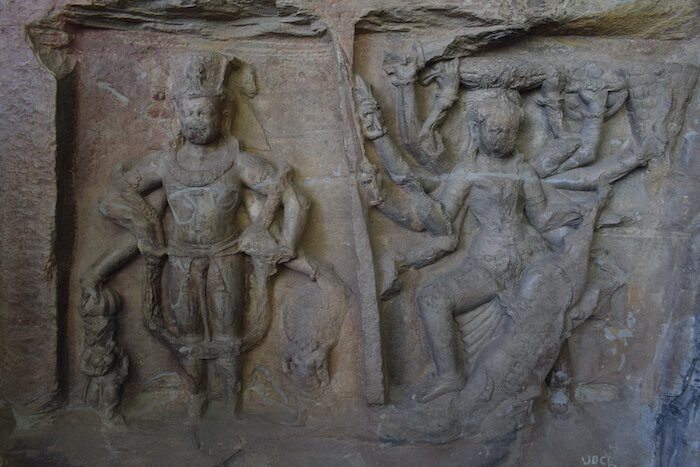
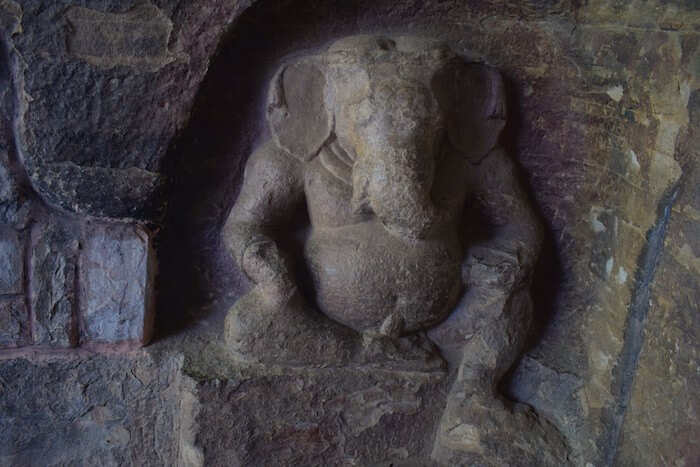
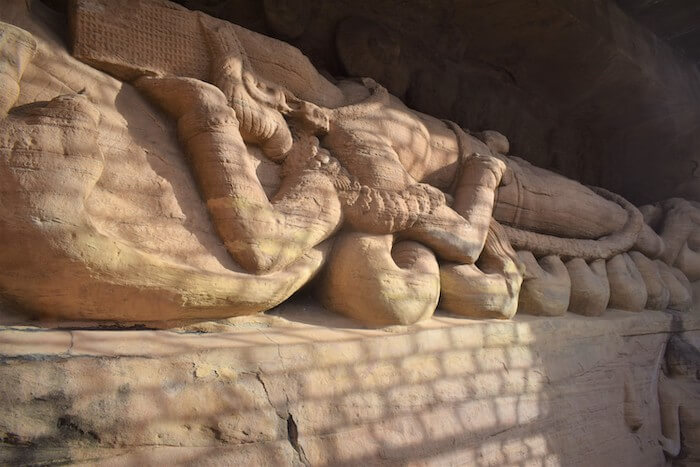
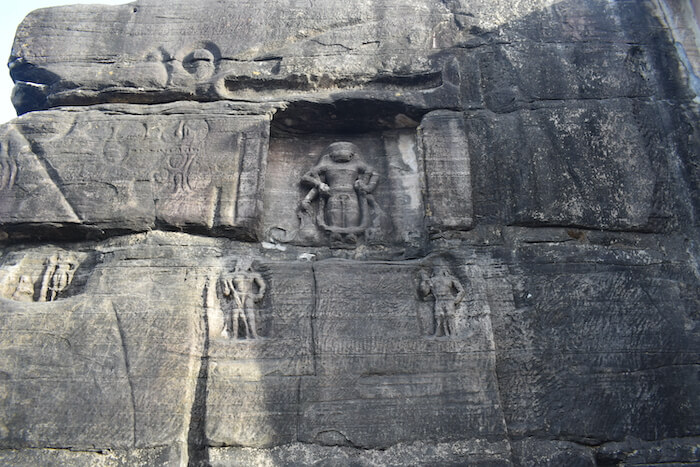
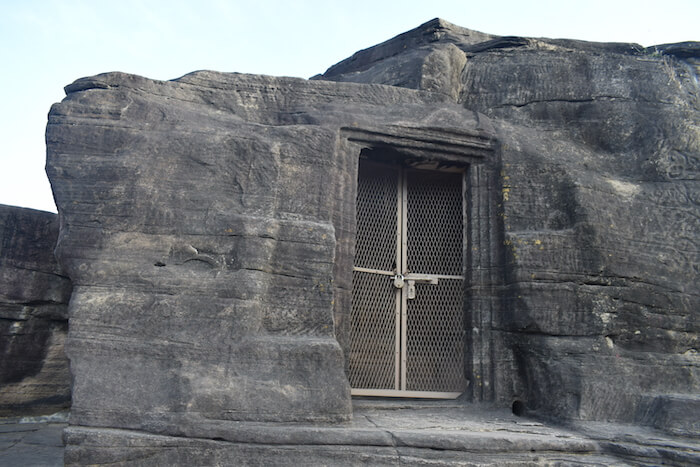
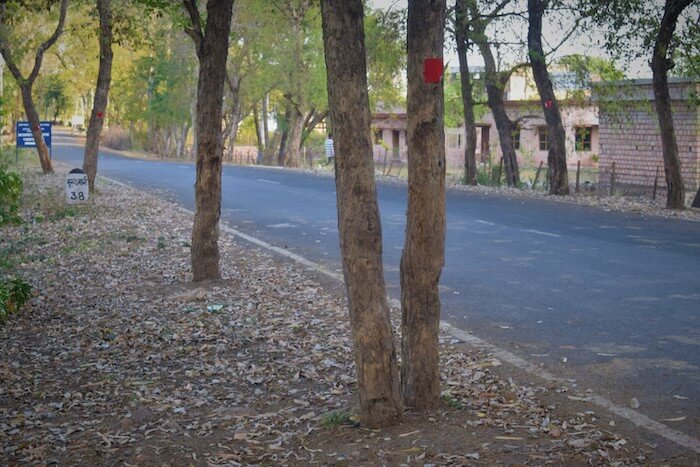

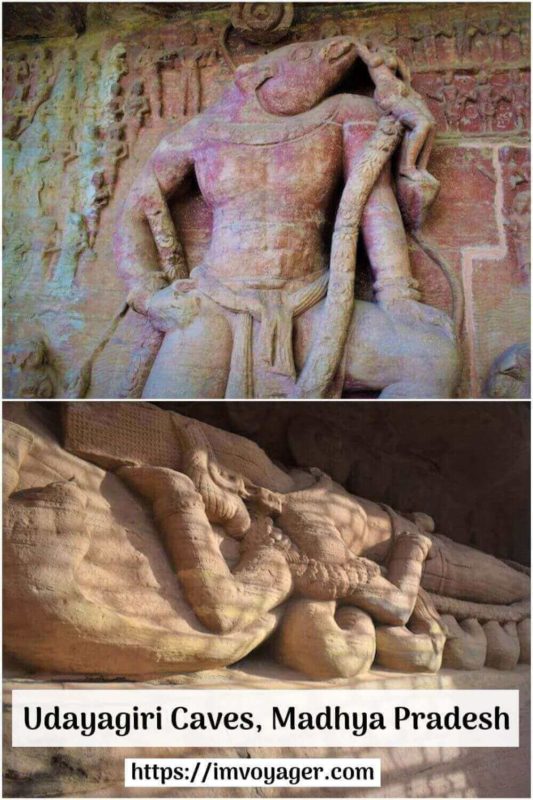

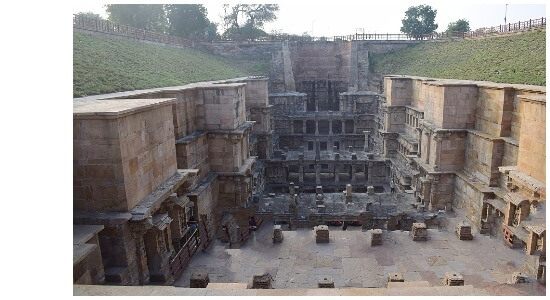
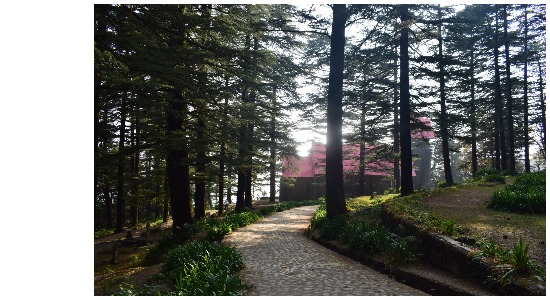
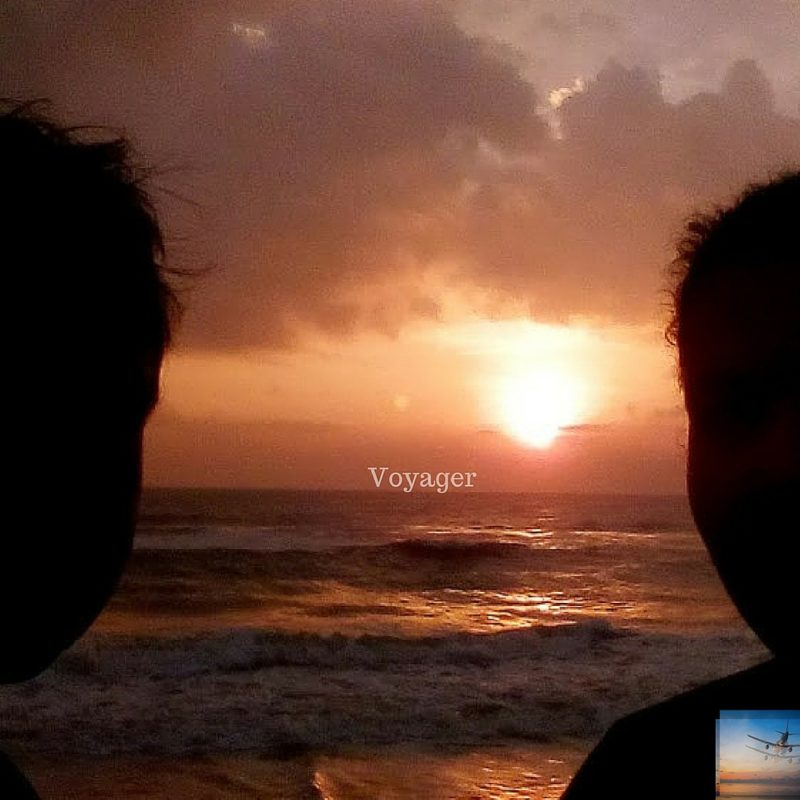
Unfortunately, when I visited Madhya Pradesh, I did not get an opportunity to visit Sanchi or Udayagiri Caves. I would really love to see these caves and explore them. I am adding these to my next visit to MP.
Thank you for this post. I am going to visit this place in my next India trip. My in-laws are from Bhopal. In our last trip, we visited Tribal Museum. And it was just too good. This time, I am going to visit these caves.
I am from MP but somehow did not get a chance to visit Sanchi and udyagiri caves. looking like a great place to explore amazing rock sculpture. will surly keep this place in mind, when visit India next time.
The rich heritage and culture of our country never ceases to amaze me. I would love to see the Udayagiri caves of Madhya Pradesh. Looks like an absolute must see, just by looking at your pictures. Once again, an offbeat destination worth exploring.
It is really a treat to see the sculptures from the 5th century, it is like revisiting the history and each cave is special. Shall add to my visit list in MP.
I’ve been collecting information about must-visit places in MP for a trip and Udaygiri caves got added to the list. Would love to see the beauty of this place firsthand.
I have heard a lot about these caves from my mother, and how incredible the place is. Sadly, in spite of staying 2 years in MP., I did not get the time to visit there. But it is definitely in my travel wish list.
Omg! The place looks inviting, your pictures are fetching tourists, I tell you!
It’s on my list of to-visit places, thanks to your blog post.
I just love the way you have described the beauty if these caves and understand why they are a major tourist attraction. Will definitely visit them when I go there
Wow these caves seems to be worth the visit I would love to see the Udayagiri caves of Madhya Pradesh. These pictures are so interesting
I never been to Madhya Pradesh in my life but heard a lot about this state thanks for sharing if I have ever make my plan I will definitely refer to this post
Wow, the place do exotic and historical. I am going to visit Bhopal next month . I will definitely plan a trip to this place also .
You written it so well. madhya pradesh is so beautiful. Will definitely visit these place of I go to madhyapradesh.